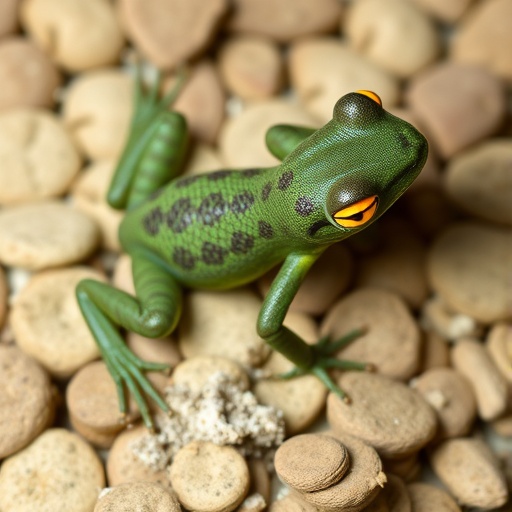In a groundbreaking study, researchers have delved into the evolutionary dynamics of the allotetraploid frog, commonly known as Xenopus laevis. This intriguing species is of particular interest not only for its unique genetic makeup but also for its adaptive strategies in various environments. The team’s findings, published in the latest issue of BMC Genomics, shed light on how both of the frog’s sub-genomes are subject to similar selective pressures. This revelation adds a new layer to our understanding of genomic evolution in amphibians.
The allotetraploid nature of Xenopus laevis sets it apart from many other amphibians. As a species resulting from the hybridization of two distinct parent species, it possesses a doubled set of chromosomes. This genomic configuration grants it both stability and diversity, allowing it to thrive in a variety of ecological niches. The evolutionary trajectory of Xenopus laevis presents an exciting opportunity to explore polyploidy and its consequences on genetic evolution.
Understanding the concept of polyploidy is essential when discussing the evolution of Xenopus laevis. Polyploid organisms, such as this frog, have multiple sets of chromosomes, which can lead to novel traits and increased resilience against environmental challenges. The unique chromosomal arrangement can facilitate genetic diversity, enabling populations to adapt rapidly to changing conditions. In this study, the researchers aimed to investigate how each of the two sub-genomes in Xenopus laevis has been influenced by similar environmental factors.
The researchers employed a combination of genomic sequencing and bioinformatics tools to analyze the genetic data from various populations of Xenopus laevis. By identifying patterns of nucleotide variation, they were able to infer the selective pressures acting on the genome. Their findings showed that both sub-genomes are exhibiting responses to similar environmental challenges, suggesting that the evolutionary paths of these genomic components are intertwined.
An intriguing discovery from the study is how the two sub-genomes, while distinct, may not be operating under completely separate evolutionary trajectories. This could imply that the two genomes are capable of complementing each other in response to external pressures. This phenomenon may enhance the species’ overall adaptability, demonstrating the advantages of a hybrid genomic structure in fluctuating environments.
The implications of these findings extend beyond mere academic interest. Understanding the evolutionary mechanisms at play in Xenopus laevis could provide crucial insights into the resilience of other polyploid species. As environmental changes increasingly threaten biodiversity, the lessons learned from this frog could inform conservation strategies aimed at preserving similar species that share characteristics of allotetraploidy.
In addition to its ecological significance, Xenopus laevis has also become a model organism in scientific research. Its unique genetics and adaptability make it an excellent candidate for studies on genetics, molecular biology, and developmental biology. By unraveling the complexities of its genome, scientists can gain broader insights applicable across various fields including medicine, evolutionary biology, and ecology.
Moreover, the study’s methodology sets a precedent for future research on polyploid organisms. By utilizing advanced genomic techniques, the researchers were able to dissect the evolutionary patterns of Xenopus laevis with a level of precision heretofore unseen. This approach could inspire similar investigations into other polyploid species, potentially reshaping our understanding of how these organisms evolve and adapt.
As the research community continues to grapple with the challenges posed by climate change and habitat loss, the insights gleaned from this study are timely. The ability of Xenopus laevis to maintain genetic integrity while responding to similar selective pressures reflects the resilience of life. Such findings could illuminate paths forward for other species facing similar ecological pressures, underscoring the interconnectedness of evolutionary processes across different taxa.
Furthermore, this research emphasizes the importance of biodiversity in sustaining ecosystems. The adaptability of polyploid species like Xenopus laevis highlights the potential for genetic variation to serve as a buffer against environmental change. Conservation efforts that focus on preserving genetic diversity within and among species may yield benefits in resilience and adaptability to changing conditions.
In conclusion, the study of Xenopus laevis and its dual sub-genomes provides a compelling narrative of evolutionary resilience. The research findings not only enhance our grasp of the forces shaping the genomes of this unique amphibian but also contribute to broader conversations about genetic diversity and conservation efforts in a rapidly changing world. As scientists continue to explore the depths of genetic evolution, the lessons learned from Xenopus laevis will undoubtedly play a vital role in guiding future research and conservation strategies.
This significant exploration into the genomic dynamics of Xenopus laevis serves as a reminder of the intricate relationships between genetics, environment, and evolution. Each discovery further unravels the complexities of life, highlighting the necessity for ongoing research in a world where environmental pressures are becoming increasingly pronounced.
Subject of Research: Evolutionary dynamics of the allotetraploid frog Xenopus laevis.
Article Title: The two sub-genomes of the allotetraploid frog Xenopus laevis are evolving under similar selective pressure in extant populations.
Article References:
Almojil, D., Manikandan, V., Drou, N. et al. The two sub-genomes of the allotetraploid frog Xenopus laevis are evolving under similar selective pressure in extant populations. BMC Genomics 26, 887 (2025). https://doi.org/10.1186/s12864-025-12036-4
Image Credits: AI Generated
DOI:
Keywords: Xenopus laevis, allotetraploid, evolution, polyploidy, genetic diversity.
Tags: adaptive strategies of Xenopusallotetraploid amphibiansBMC Genomics research findingschromosomal arrangements in evolutionenvironmental resilience in polyploidsgenetic diversity in amphibiansgenomic evolution in amphibianshybridization effects in geneticspolyploidy in frogsselective pressures in evolutionsub-genome dynamicsXenopus laevis evolution




